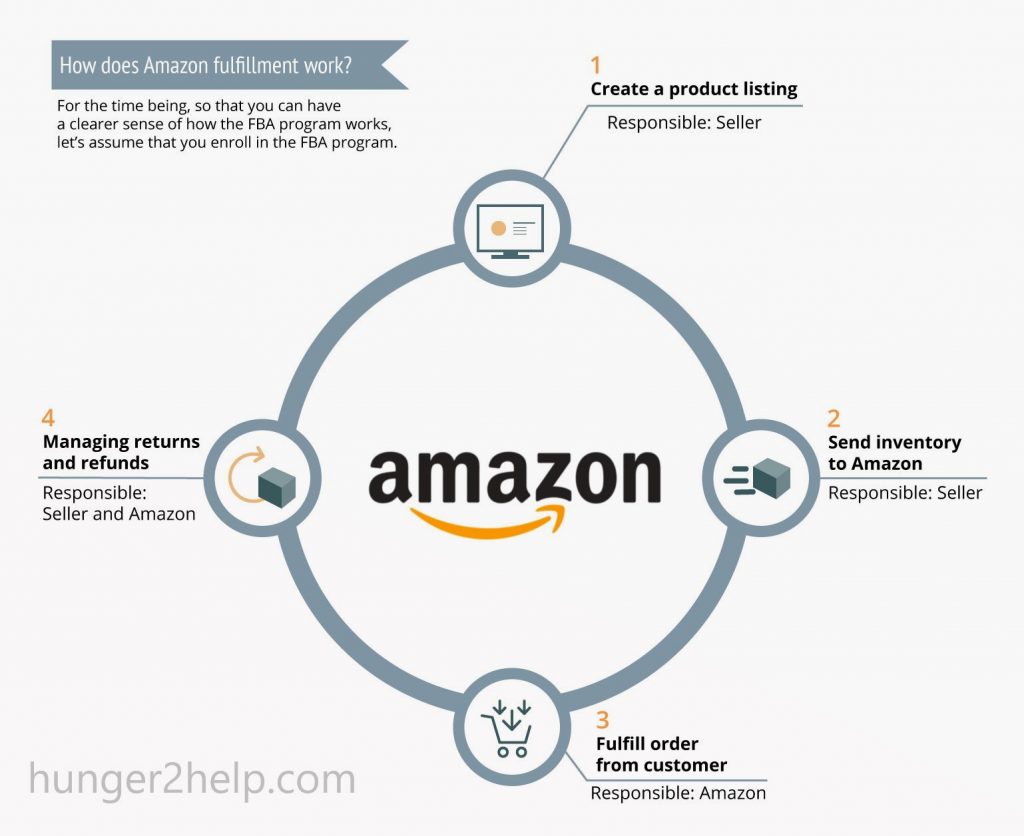Following are the business models of Amazon sellers:
Private Label :
Private label is the practice of manufacturing bulk products to sell under one’s own brand or label. 71% of all Amazon sellers use the private label business model.
Wholesale :
Whereas private label involves selling one’s own brand, wholesale is the process of purchasing.
Another company’s branded products in bulk to resell on Amazon. 27% of Amazon sellers use the
wholesale model.
Reselling (Arbitrage) :
Resellers practice retail or online arbitrage by purchasing discount products at retail outlets, big box stores, or even online on discount sites like eBay to sell at a higher price on Amazon.
20% of Amazon sellers use retail arbitrage and 15% use online arbitrage.
Drop shipping :
Drop shippers market and sell products of another manufacturer or supplier.
When a sale is made, the drop shipper purchases the product from the supplier who in turn ships the product to the buyer. 8% of Amazon sellers are drop shippers.
Entire process we’ve discussed above is a risky model on Amazon because of some policies of copyrights and legal issues Amazon suspend the seller account.
Handmade :
Handmade Amazon sellers create their own products to sell on Amazon, like jewelry, clothing, or gifts.
Unlike the other business models mentioned above, Amazon Handmade has its own separate section on the platform.
6% of Amazon sellers sell via Amazon Handmade.

AMAZON FBA VS FBM:
There are two fulfillments Method on Amazon, FBA and FBM.
FBA:
The way of selling on Amazon in which a seller sends their products directly to Amazon’s
warehouses.
Amazon then stores the inventory and ships it directly to the customer (often through 2-day Prime shipping) and manages customer support.

FBM:
The way of selling on Amazon in which a seller lists their products on Amazon, but manages all storage, shipping.
Customer support themselves (or through another third party). This is called Merchant Fulfillment Network or MFN.
94% of Amazon sellers use FBA
66% of Amazon sellers use only FBA
28% of Amazon sellers use both FBA and FBM
34% of Amazon sellers use FBM
6% of Amazon sellers use only FBM
How does Amazon FBM work?
After inaugurate the retailer account on Amazon and creating the listings, sellers have two ways to deliver their products.
They can either use Amazon’s fulfillment process to ship your orders on their behalf, that is, Amazon FBA or, they can do it by themselves and go with the FBM Amazon way.
The merchants are responsible for shipping the orders to the customer’s delivery address, from their warehouse location.
The place where they have stored the products.
The MFN (Merchant Fulfilled Network) seller is responsible for handling returns and providing customer service.
Amazon merchants who are going this way need to keep FBM shipping in mind.
They need to find delivery companies who are reliable and most importantly, cost-effective.
If FBM shipping charges are higher than the fees incurred with FBA, then it doesn’t make sense for merchants to fulfill the orders by themselves.
As it will only impact their margins negatively. When to choose FBM for Product Fulfillment.
FBM is better for exclusive products, small volume products or products with lower profit margins.
FBM is better for:
Exclusive products – products that have a lower frequency of sales.
Products with lower profit margins – helps save on the warehousing and storage fees on FBA.
Situations where FBM works out to be cheaper than FBA. Fulfillment fees depend on the weight and measurement of the product.
If sellers can ship their orders for a better price in comparison to using FBA through their delivery networks, then it is better to opt for FBM.
FBA vs. FBM — the Pros and Cons:
Each business is different and one of these two methods (or a mix of both) may be more dominant for your growing business.
Amazon encourages its sellers to take advantage of its FBA module; It provides a better customer experience.
Or reduces some of the more inconvenient aspects of online selling.
However, FBA may not be the best option for everyone, and it pays to look at some of the benefits and disadvantages of the program.

ADVANTAGES OF AMAZON FBA MODULE:
Prime Enrollment:
Amazon automatically enrolls third-party sellers using FBA in their Prime Program.
It’s estimated that Amazon Prime has 95 Million people in the U.S. alone, and Prime members are more probably to spend money than non-Prime members.
More Time:
FBA takes the burden of storing and shipping products off your hands, allowing Amazon to manage and take responsibility for these factors.
For some Amazon sellers, this means extra time spent focusing on business concerns and less time spent dealing with the logistics associated with selling your products.
Lower Shipping Cost:
For many Amazon sellers, the fees that Amazon charges to ship products are lower than what shipping fees would be.
If sellers handled their logistics internally.
If Amazon’s shipping is less expensive than yours, FBA selling saves your business money by giving you shipping benefits.
Inventory Management:
As, seller paid fee to Amazon they took care for their inventory for them and dispatch them as in best for customer satisfaction.
Return Handling and Customer Services:
In FBA module the seller is free of stress for the returns because Amazon is handling or managing returns from client.
On the behalf of seller and Amazon do better care of customer service. They’ve complete command on customer service inquiries.
DISADVANTAGES OF AMAZON FBA MODULE:
Limited Inventory Access:
Without inventory on-site, sellers have less control over their products. Just in case problems with your inventory or shipping mistakes.
You will have to rely on Amazon to verify product details or have your products shipped back to you from Amazon’s inventory.
Long-Term Storage Fees:
In February and August of each year, Amazon goes through their inventory, and charges penalty fees for any item elderly than 6 and 12 months.
If you have slower moving products, heavy products or more than 6 months of inventory, storing.
Those types of items at inventory will increase your unexpected costs and you will extra charge by Amazon.
FBM:
There are a number of situations where using FBM may make more sense. Here we discuss a few of the pros and cons of FBM selling.

ADVANTAGES OF AMAZON FBM MODULE:
New Prime Program:
A new program from Amazon allows third-party sellers to enroll their products in the Prime Program when filling orders them.
To enroll products in the Seller Fulfilled Prime program, Amazon will need that sellers show they can meet stricter shipping standards.
More Inventory Control:
Selling using FBM means you have complete control when complications arise.
Hands-on access to your inventory allows you to sail wrong shipping and product quality issues without the delays associated with going through Amazon.
Lower Cost:
Amazon bases their fee module on the size of the product being sold, so you’ll need to analyze this aspect for your products.
If you have a larger product with a small profit margin or a slower retail rate.
You may want to fulfill this product yourself in order to save money on shipping and storage fees.
DISADVANTAGES OF AMAZON FBM MODULE:
Shipping Mistakes:
Amazon puts a big value on customer service, so shipping mistakes like a late or wrong shipment will incur penalties for sellers, and account deactivation.
It takes a highly disciplined shipping method to avoid shipping mistakes.
Be sure you have the right tools and team in place to accurately pack and ship orders.
Stiff Competition from FBA Sellers:
A common complaint that many FBM sellers have is that they lose most of their sales to FBA sellers.
Amazon customers often prefer to buy products that have the Prime badge and are FBA.
One way to counter this would be effective brand marketing, combined with a good product, good reviews, competitive pricing, and joining the SFP.
Other Overheads:
Even though you aren’t paying FBA fees, you will have other overheads to overview like staff charges, warehouse rent, utilities, et cetera.
Therefore, before going down this road, it is strongly recommended that you make the calculations properly.
Also check out DHL with deliver courier , Difference between first and second degree murder. , What is the starting check number? , How much time required to get driving license?
Note: If any question rise regarding this article you can ask thanks for studying this article I hope this article is very beneficial for you.
Hi I’m Bilal Malik, a digital marketing and blogging expert holding years of experience.










